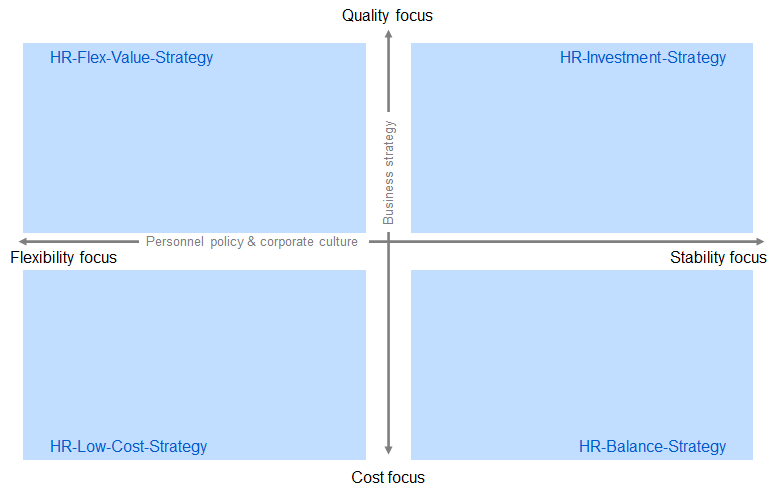We are not only familiar with terms like volatility and agility, we use them and experience what they mean on a daily basis. But how does this fit in with strategy and planning?
Are those right who claim that planning only makes sense in the short term because we don’t know what will happen to companies and society in a few months and have to act spontaneously right?
Are those right who are convinced that strategies are something for strategy consultants, but in everyday business they are not even worth the paper on the office walls?
I mean no! Especially in these times, strategy and planning are immensely important; but in a different way than it has been practiced for many years! For this I structure this blog post as follows:
- Volatility and agility act as a catalyst to seize new opportunities
- Realignment of the key account business at a global financial institution (practical example)
- Need for new HR strategies
Volatility and agility act as a catalyst
Executives play a central role in dealing with volatility and agility. In the positive case, they rethink their merger and acquisition strategies, make more drastic shifts in resources, and reconsider the composition of their workforce. Finally, they are taking a long-term perspective on innovation and growth.
To take advantage of emerging opportunities, McKinsey consultants emphasize three factors: insights, commitment and execution:
Insights
At its core, this is about gaining advantage in knowledge through high-quality analysis. Guiding questions could be:
- Do we have a complete overview of our supply chain?
- Are we evaluating our portfolio at a sufficiently granular level and fast enough to identify region- or segment-specific features?
- How well do we know our customers and end users?
- Do we have a mechanism in place to turn signals from across the business into actionable options as quickly as possible?
- Are we building a culture that is diverse, inclusive and outside-in?
- Have we built digital and analytical capabilities across the enterprise?
Commitment
This is primarily about acting quickly and comprehensively. Guiding questions could be:
- Are our senior leaders able to make strategic decisions decisively, or do we need to change team composition, processes or mindset to ensure this?
- Have we sufficiently involved senior management in developing scenarios and responses to them so that they do not impede bold moves at key moments?
- Can we dynamically reallocate some of our capital and operating expenditures as new opportunities and/or risks arise?
- Do we have industry peers and cross-industry disruptors, so-called nightmare competitors, in mind so that we can act on a sufficient scale?
Execution
In strategy execution – e.g. along the 4DX framework – it is primarily about focus and clarity! Guiding questions could be:
- Are we questioning our organization in order to act in a more focused and targeted way?
- Is our technology modern and modular enough to accelerate implementation?
- Are our capabilities that support growth strong enough?
- Are we able to build new businesses with the agility and ambition of a disruptor while leveraging the reach and resources of an established company?
- Have we examined best practices for transformation to see if they can be implemented in our organization?
- Are we capturing and evaluating lessons learned from significant past experiences?
Realignment of the key account business at a financial institution
Wholesale banking has been transformed in the decade since the financial crisis. Many business areas have been digitized, customer needs are becoming more complex and integrated, and the industry has de-risked and de-leveraged.
However, demanding large customers expect further developments.
Using the example of a financial institution, I show how the three factors described above have been integrated in concrete terms.
Insights
- In addition to modernizing and automating workflows, the Institute has simplified the daily tasks of its employees and given them tools to understand their customers holistically.
- The rich data the institute has have been used to generate information that helps account managers anticipate their customers’ needs before they even know they have them.
- With the help of AI tools, a much clearer picture of customers (microsegmentation, machine learning) is possible.
- Clerks are now able to use the insights gained to prove what they know about customer strategy and incorporate it into their advice.
- The institute has developed an easily searchable, structured content management system and thus built its own knowledge repository.
Engagement
- The initiative has led to improved strategic dialogue with management and customers, based on new data and insights, and better collaboration across traditional silos.
- Customers have been included in the product development process, and cross-product solutions have also been co-developed (banking services, for example, have been fully integrated with the customer’s ERP system).
- Clerks can now be highly responsive; unhindered by internal delays, silos and bureaucracy.
Execution
- Processes were accelerated, simplified and made measurable by means of rationalization and automation on the customer front.
- At the same time, the quality of advice provided to key accounts was significantly improved.
- A major part of the implemented changes is to integrate data and analytical capabilities into every part of the business model.
- Data was brought together in a single wholesale platform. Alongside this, there has been a heavy investment in technology to transform data from raw data pools into actionable data sets, enabling use cases to be developed and insights to be provided to senior management based on this data.
- A culture has been established where technical teams collaborate with product teams – across departments and silos.
- Strategy is reviewed with executives on an ongoing basis; engagement and accountability are particularly important.
- A constant velocity of feedback loops ensures agility is maintained across the organization.
The need for new HR strategies
The effects of a VUCA world outlined here so far have far-reaching implications for the workforce in general and for the HR function in particular. Therefore, at the beginning of an HR strategy development, the basic thrust should first be worked out. Three so-called consistency factors play a role here: corporate strategy, HR policy and organizational culture. Mapping these factors results in the following matrix:
The horizontal axis of the HR core strategy matrix is just as important – if not more important – than the vertical axis with a focus on quality and cost.
According to this matrix, a spectrum appears between flexibility on the one hand and stability on the other.
Flexibility stands for networking and agility and aims at employee-centric empowerment. The focus here is on the question of what employees, teams and networks need in order to be able to master personnel-relevant challenges on their own responsibility. The basis for this is often a changing basic attitude and corporate culture.
At a time when change is happening faster and faster, an HR strategy focused on agility has many advantages. Therefore, ask yourself:
- What is the current desired understanding of leadership and organization? Agility and networking versus stability and hierarchy?
- What core HR strategies are derived from this leadership and organizational understanding?
The following comments are certainly incomplete; however, they hopefully form the basis for interesting comments on this article.
Insights
- Clarity about the HR core strategies as well as the characteristics of assigned HR key figures and KPIs, such as the relationship between HR total cost and total revenue of the company, provides a clear insight advantage.
- This has an impact on the further procedure in the context of HR strategy development (HR strategic fields of action, HR portfolio, etc.), as well as on the development of a consistent HR structure or HR organization.
- In the context of people analytics (also: workforce analytics), predictive analyses are created, among other things, which produce additional insights and make evidence-based management possible.
- Transparency about workforce segments as well as key and bottleneck functions is also essential, especially in the context of strategic workforce planning and HR risk management.
Engagement
- The consistent derivation of HR strategic action areas and the alignment of HR best-fit activities (also: key activities) is different in an agile environment than in a context striving for stability.
- As an example, I will briefly discuss the HR flex value strategy with a focus on quality and flexibility. In this HR strategy, the company strives above all to adapt quickly and agilely to changes in the environment. Targeted investments in specific areas of HRM alternate with cost-cutting initiatives aimed at optimizing processes and efficiency. The important thing is that agility and flexibility must stabilize at a level that does not place a lasting burden on the company, but is permanent and at the same time leaves room for targeted innovation and sustainable development.
- With such a strategy, HR planning therefore tends to be short-term and operationally oriented, the recruitment function is often outsourced – at least partly – and employee compensation is strongly performance-oriented. In addition, staff retention is only on the agenda for designated functions.
- This example should demonstrate: Without comprehensive knowledge of the company’s purpose, strategic positioning and challenges, strategic thinking as well as fast and comprehensive action in HR is not even remotely conceivable.
- In practice, it can be seen that HR areas that emphasize the stability focus too much do not play a major role in “everyday business”, i.e..: HR is not perceived as a business partner, “shadow organizations” directly in the business units take over strategic HR tasks, and the HR function itself is reduced to administrative tasks with a cost focus.
Execution
- HR should act as a change agent during implementation. In traditional change management projects, however, employees feel too much like they are being dictated to and patronized by others, and they fear that they may emerge from the change as losers. In an agile context, change management – I like it better here: comprehensive transformation management – means continuous change, many small changes driven by employees, involvement as early as possible, experimentation, failure, continuous learning and scaling of what is successful.
- As part of strategic workforce planning, purposeful, appropriately granular competency management should be introduced. Meaningful operational action plans are then derived from this.
- In the practical example above, the clerks have acquired new competencies in strategy, analytics, and customer interaction to fill their “new” roles.
- HR itself needs to develop new competency areas; primarily change and digitalization competency, downstream also consulting, problem solving, self-management and work design competency.
Conclusion
Three factors are essential to seizing opportunities presented by volatility and agility. It enables companies to respond quickly to changing conditions and take advantage of strategic options as they arise.
It takes strategic courage on the part of executives to use times of crisis, change and disruption to establish these three factors. The HR function should be closely involved in this process.
CAGR evaluations impressively prove that this courage also pays off.



Leave A Comment